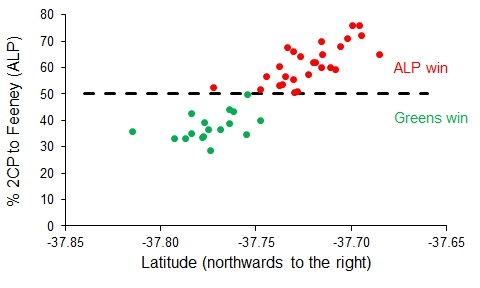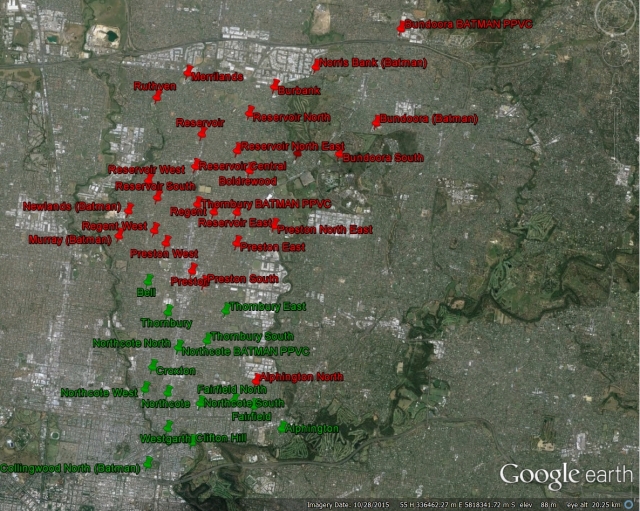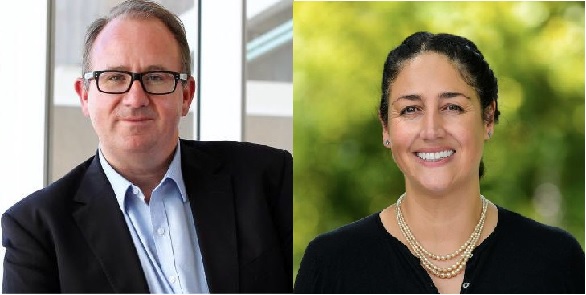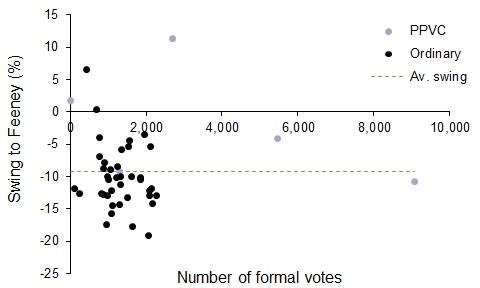Update (9 July, 1:30 p.m.)
The postals votes have drifted a little back toward Bhathal, but Feeney still has 56.62% of them. Some absent votes have now been counted, which are currently favouring Bhathal (55.97%), but she is trailing by almost 3000 votes.
And for a bit more on the Hipster-proof Fence, it is worth noting that the swings in Wills were very consistent across the electorate, but Bhathal’s swings were much weaker north of Bell St.
Update (6 July, 11:30 p.m.)
I should probably change the title of this post to “#Batman all but decided”. With almost 2000 postal votes counted, Feeney is winning >60% of them on a 2CP basis, and now leads Bhathal by 2761 votes.
My map of “The Hipster-Proof Fence” (formerly known as Bell St) has been reported in The Age.
For the record, I like “The Tofu Curtain” too.
Update (5 July, 10:30 p.m.)
Postal votes are not swinging away from Feeney at this stage. He is winning 62.86% on 2CP after a little over 1000 counted. That is actually better than the 60.77% he won in 2013 for postals. An unlikely result for Bhathal just became much more unlikely.
Update (4 July, 9:00 p.m.)
Tim Wardrop mapped the ALP:Greens booth outcomes in Wills. You can see it here on Twitter.
And if you are wondering what is happening in other seats, I suggest keeping an eye on Kevin Bonham’s blog. (Also, I have an analysis of preference flows in Indi, which indicates why the Liberals seem cranky at some of the Nationals voters who didn’t prefer their candidate over Cathy McGowan.)
Update (4 July, 5:30 p.m.)
As a point of comparison to the geographic gradient of 2CP in Batman, here are the equivalent data for Wills:

The two-candidate-preferred vote to Khalil (ALP) versus Ratnam (Greens) in each of WIlls’ pooling booths. It is the same basic geographic pattern as seen in Batman.
And in terms of counting of Batman, the small hospital booths have been processed, and they favoured Feeney as in previous years. His lead is now >2300 votes.
Update (3 July 2016, 9:40 p.m.)
The geographic gradient in the Batman vote is perhaps even more dramatic if Feeney’s 2CP vote is plotted versus latitude of the polling booth (i.e., how far north the polling booth is):

The two-candidate-preferred vote won by Feeney (ALP) versus Bhathal (Greens) in each of Batman’s pooling booths. The ALP retains a very strong vote in the north of the electorate, while the Greens dominate the south.
Update (3 July 2016, 3:40 p.m.)
The count hasn’t updated, but I have mapped the two-candidate-preferred outcome by polling place. There is a major north-south gradient in the preference for ALP versus Greens. So the outcome of the early/postal/pre-polls will to some extent reflect where those voters live. Given the geographic difference, those votes could be quite different from the ordinary votes if there is a geographic bias in the location of the voters.

Map of polling booths in Batman colour-coded by the winner of the two-candidate-preferred vote. Feeney (ALP) won the red booths, and Bhathal (Greens) won the green booths (click to get a larger version).
The swings were also geographically structured, although not quite so dramatically. Nevertheless, the three booths with a swing toward Feeney were all in the far north east of the electorate, and all booths with a swing toward Bhathal of less than 6% were in the northern half. The majority of booths with a swing toward Bhathal of >12% were in the south.
A quick look suggests a similar north-south gradient in voting occurred for the neighbouring seat of Wills.

David Feeney and Alexandra Bhathal, the two leading candidates in the 2016 election for the federal seat of Batman (photos from their Twitter profiles).
Update (3 July 2016, 8:10 a.m.)
The AEC website updated overnight, and the new data are more hopeful for Feeney and less hopeful for Bhathal. The percentage of the vote counted is the same as last night, but Bhathal is now reported to have only 48.55% of the vote, trailing by 2074 votes.
The swing by booths (only for those booths used in 2013 as well as 2016) suggests the average swing is 9.3% away from Feeney. For Bhathal to win, she needs a swing of around 11.5% in the non-ordinary votes, which would net her around 55.5% of those votes. That seems unlikely to me.
Here are the swing data for each booth: versus the number of formal votes in those booths. The pre-poll voting centres (PPVC) are highlighted.

Original post:
With just over 70% of the vote counted (11:15 p.m. 2 July 2016), the election for the seat of Batman is close. The AEC website, disappointingly, does not provide results for individual polling booths, unlike in 2013. Despite that, we can examine the swing as best we can.
David Feeney (ALP) currently has 50.3% of the two-candidate-preferred (2CP) vote against Alexandra Bhathal (Greens) on 49.7%. That translates to a difference of around 650 votes.
Most of the ordinary votes have been counted for this election in Batman. In 2013, Bhathal won 38.08% of the ordinary votes, so the swing to her is approximately 11.6%. She needs a swing of less than that on the remaining votes to win the election.
The remaining votes are mainly early, postal and absent votes. In 2013, Bhathal won 43.9% of these non-ordinary votes. We might expect about 20,000 of these votes (the approximate number in 2013 – there might be more in 2016). A swing of 8% towards Bhathal in these non-ordinary votes would be sufficient for her to recover her current deficit of 650 votes.
It is entirely conceivable that Bhathal will win 52% of the non-ordinary votes, and win the seat. Batman is on a knife edge.
Addition (11:50 p.m.):
2013 Results:
Ordinary 2CP to Bhathal 38.08%
Non-ordinary 2CP to Bhathal 43.93%
2010 Results (vs Martin Ferguson):
Ordinary 2CP to Bhathal 42.06%
Non-ordinary 2CP to Bhathal 42.53%
Based on that history, anything is possible in terms of a difference between ordinary and non-ordinary votes.
Details for 2013 here.
Details for 2010 here.


Pingback: Batman By-Election 2018 | Michael McCarthy's Research
Pingback: Chisholm: Polling Booths | Licensed to Pen
Pingback: Swinging on the Hipster-proof Fence | Michael McCarthy's Research
Pingback: Be careful what you wish for – the 2016 Federal election edition – Home Base